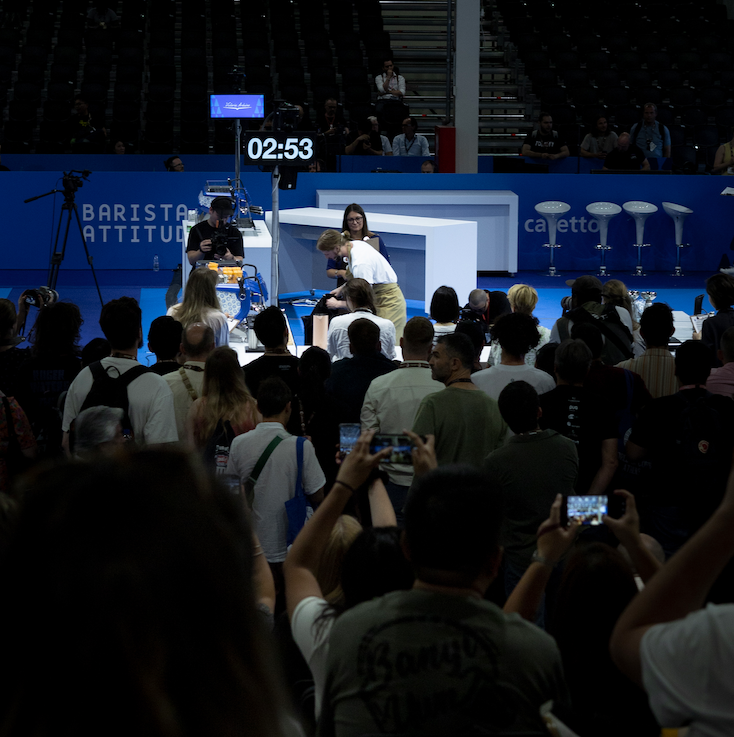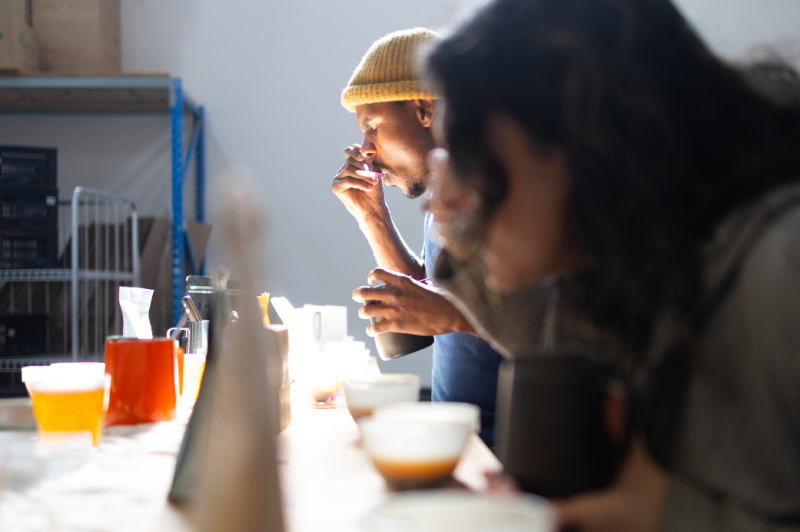
Patrik Rolf, who placed 6th at the World Barista Championships held in Athens, Greece this year, competes in front of a large crowd of eager coffee enthusiasts.
When we think of “coffee competitions”, what comes to mind can be something quite outlandish. Why would anyone want to compete in coffee? How do you compete in coffee? How do you judge a coffee competition? (See our Spectators Guide to Coffee Comps here)
Coffee competitions can be extreme: baristas giving drinking instructions to the exact temperature of your first sip, equipment that looks like it belongs at NASA and coffee information that sounds like a foreign language. So, how does this even begin to relate to the person getting a cappuccino from their local café, or the barista serving that cappuccino?
Coffee competitions, ultimately, lead to industry progress. They establish the current highest standard of producing, serving and brewing coffee, and they build on it. As much as these standards might seem ludicrous altogether, there are individual aspects of competition equipment, coffee and presentations that pose exciting opportunities for coffee businesses.
Fanie Botes, who placed 3rd in the South African National Barista Championships in 2023, comments that “it’s a very niche space in specialty coffee, but I think it also has its purpose. Research, new ideas and new inventions and new processing methods need to be shared” and competition is where these often come from.
As an example, the winner of the 2015 World Barista Championship, Saša Šestić introduced carbonic maceration as a coffee processing method. Carbonic maceration has been used as a wine-processing method for many years whereby “the first phase of fermentation is conducted in a completely anaerobic atmosphere, which transforms a small amount of malic acid and sugar in grapes to ethanol”. Similarly, whole coffee cherries are placed in a carbon dioxide-rich sealed container where they ferment in the CO2, which brings out bright, boozy notes in the coffee. In the wine making process, ethanol is produced. To avoid this in the carbonic maceration of coffee, the coffee is kept at a low temperature to avoid the alcohol build up.
Today, carbon maceration is widely known in the specialty coffee industry and is being widely used to bring different flavour experiences to customers. It cannot be denied the role that the World Barista Championship played in the rise in popularity of this processing method. As the champion, Saša Šestić caught the attention of the specialty coffee community and carbonic maceration coffees have since been a staple of any roastery’s special release menu.

Slurp, Taste, Repeat!
Fanie goes on, “It is a great platform for people to speak about innovative concepts and research that is being done that wouldn’t otherwise be recognised at a barista-consumer level.” The work being done throughout the entire coffee supply chain doesn’t always reach consumers, coffee competitions allow for years of research and innovation to be beautifully presented in a 15 minute presentation.
There are a number of new technologies that have been debuted at coffee competitions and slowly “trickled down” to home baristas and cafés all around the world. In 2022, Anthony Douglas used the Weiss Distribution Technique in his set that won the World Barista Championships. Although the technique was developed in 2005 by John Weiss, the tool that Anthony used wasn’t commercially available at the time and Barista Hustle’s new product was launched and showcased on the world stage. The tool is designed to evenly distribute ground coffee in your portafilter to avoid channelling and other extraction defects. It is a great step for café baristas to add to their workflow that will create consistently well-extracted and balanced espresso shots.
The coffee competition stage allows a space for new ideas to be presented that push coffee forward. New equipment, improved efficiencies, new coffees, supply-chain changes and innovative ideas can be shared and further explored. However, the extremity of coffee competitions can push consumers away. As coffees become increasingly expensive and therefore more exclusive, there is a risk of completely losing relatability and interest. Similarly, technology and equipment innovation often pushes prices up and can be unattainable for the local café or home barista to adopt. However, the alternative could severely stagnate the industry.
Specialty coffee is a young industry, innovation and change is key to its future. As the insufficiencies and injustices of the coffee supply chain loom over the heads of today’s consumers and businesses alike, it’s difficult to picture a future where nothing actually changes. This is where coffee competitions play their most vital role. It is only through innovation and experimentation that strides forward can be made. Perhaps the innovations that were made at the competition level in 2023 largely won’t affect the daily takeaway cappuccino customer, but it is almost guaranteed that some aspect of the coffee they’re drinking is because of competition innovation. From the producer using a specific processing method to the temperature that the espresso machine is set at, the slow trickle down is undeniable.